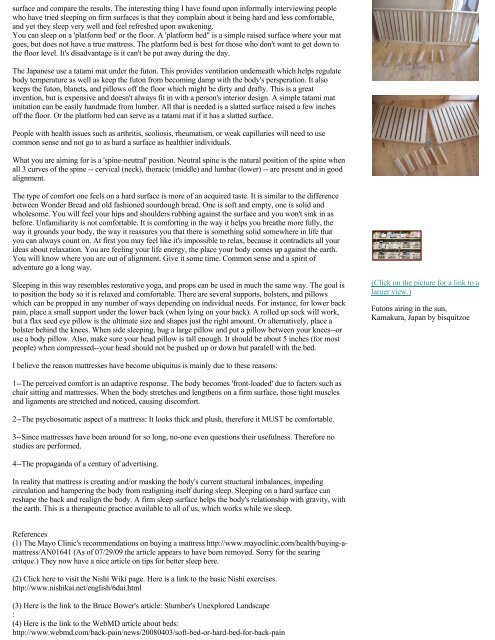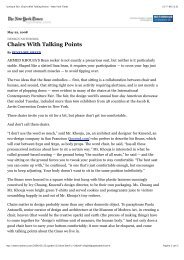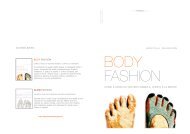sleep ergonomics - Body Conscious Design
sleep ergonomics - Body Conscious Design
sleep ergonomics - Body Conscious Design
You also want an ePaper? Increase the reach of your titles
YUMPU automatically turns print PDFs into web optimized ePapers that Google loves.
surface and compare the results. The interesting thing I have found upon informally interviewing people<br />
who have tried <strong>sleep</strong>ing on firm surfaces is that they complain about it being hard and less comfortable,<br />
and yet they <strong>sleep</strong> very well and feel refreshed upon awakening.<br />
You can <strong>sleep</strong> on a 'platform bed' or the floor. A 'platform bed" is a simple raised surface where your mat<br />
goes, but does not have a true mattress. The platform bed is best for those who don't want to get down to<br />
the floor level. It's disadvantage is it can't be put away during the day.<br />
The Japanese use a tatami mat under the futon. This provides ventilation underneath which helps regulate<br />
body temperature as well as keep the futon from becoming damp with the body's persperation. It also<br />
keeps the futon, blanets, and pillows off the floor which might be dirty and drafty. This is a great<br />
invention, but is expensive and doesn't always fit in with a person's interior design. A simple tatami mat<br />
imitation can be easily handmade from lumber. All that is needed is a slatted surface raised a few inches<br />
off the floor. Or the platform bed can serve as a tatami mat if it has a slatted surface.<br />
People with health issues such as arthritis, scoliosis, rheumatism, or weak capillaries will need to use<br />
common sense and not go to as hard a surface as healthier individuals.<br />
What you are aiming for is a 'spine-neutral' position. Neutral spine is the natural position of the spine when<br />
all 3 curves of the spine -- cervical (neck), thoracic (middle) and lumbar (lower) -- are present and in good<br />
alignment.<br />
The type of comfort one feels on a hard surface is more of an acquired taste. It is similar to the difference<br />
between Wonder Bread and old fashioned sourdough bread. One is soft and empty, one is solid and<br />
wholesome. You will feel your hips and shoulders rubbing against the surface and you won't sink in as<br />
before. Unfamiliarity is not comfortable. It is comforting in the way it helps you breathe more fully, the<br />
way it grounds your body, the way it reassures you that there is something solid somewhere in life that<br />
you can always count on. At first you may feel like it's impossible to relax, because it contradicts all your<br />
ideas about relaxation. You are feeling your life energy, the place your body comes up against the earth.<br />
You will know where you are out of alignment. Give it some time. Common sense and a spirit of<br />
adventure go a long way.<br />
Sleeping in this way resembles restorative yoga, and props can be used in much the same way. The goal is<br />
to position the body so it is relaxed and comfortable. There are several supports, bolsters, and pillows<br />
which can be propped in any number of ways depending on individual needs. For instance, for lower back<br />
pain, place a small support under the lower back (when lying on your back). A rolled up sock will work,<br />
but a flax seed eye pillow is the ultimate size and shapes just the right amount. Or alternatively, place a<br />
bolster behind the knees. When side <strong>sleep</strong>ing, hug a large pillow and put a pillow between your knees--or<br />
use a body pillow. Also, make sure your head pillow is tall enough. It should be about 5 inches (for most<br />
people) when compressed--your head should not be pushed up or down but paralell with the bed.<br />
I believe the reason mattresses have become ubiquitus is mainly due to these reasons:<br />
1--The perceived comfort is an adaptive response. The body becomes 'front-loaded' due to facters such as<br />
chair sitting and mattresses. When the body stretches and lengthens on a firm surface, those tight muscles<br />
and ligaments are stretched and noticed, causing discomfort.<br />
2--The psychosomatic aspect of a mattress: It looks thick and plush, therefore it MUST be comfortable.<br />
3--Since mattresses have been around for so long, no-one even questions their usefulness. Therefore no<br />
studies are performed.<br />
4--The propaganda of a century of advertising.<br />
In reality that mattress is creating and/or masking the body's current structural imbalances, impeding<br />
circulation and hampering the body from realigning itself during <strong>sleep</strong>. Sleeping on a hard surface can<br />
reshape the back and realign the body. A firm <strong>sleep</strong> surface helps the body's relationship with gravity, with<br />
the earth. This is a therapeutic practice available to all of us, which works while we <strong>sleep</strong>.<br />
References<br />
(1) The Mayo Clinic's recommendations on buying a mattress http://www.mayoclinic.com/health/buying-amattress/AN01641<br />
(As of 07/29/09 the article appears to have been removed. Sorry for the searing<br />
critque.) They now have a nice article on tips for better <strong>sleep</strong> here.<br />
(2) Click here to visit the Nishi Wiki page. Here is a link to the basic Nishi exercises.<br />
http://www.nishikai.net/english/6dai.html<br />
(3) Here is the link to the Bruce Bower's article: Slumber's Unexplored Landscape<br />
:<br />
(4) Here is the link to the WebMD article about beds:<br />
http://www.webmd.com/back-pain/news/20080403/soft-bed-or-hard-bed-for-back-pain<br />
(Click on the picture for a link to a<br />
larger view.)<br />
Futons airing in the sun,<br />
Kamakura, Japan by bisquitzoe






